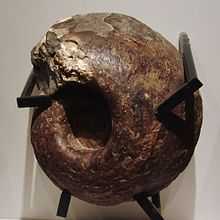Fagesia
| Fagesia Temporal range: Turonian | |
|---|---|
 | |
| Fossil of Fagesia spheroidalis from Japan. Late Cretaceous. Exhibit in the National Museum of Nature and Science, Tokyo, Japan. | |
| Scientific classification | |
| Kingdom: | Animalia |
| Phylum: | Mollusca |
| Class: | Cephalopoda |
| Subclass: | Ammonoidea |
| Order: | Ammonitida |
| Superfamily: | Acanthocerataceae |
| Family: | Vascoceratidae |
| Genus: | Fagesia Pervinquière 1907 |
| Species | |
| |
Fagesia is a small, subglobular ammonite (suborder Ammonitina) belonging to the vascoceratid family of the Acanthocerataceae that lived during the Turonian stage of the late Cretaceous, 92-88 Ma ago.
The shell of Fagesia is about 9.5 cm (3.47 in) in diameter, typically with blunt umbilical tubercles from which spring 2 or three ribs each, but which are lost in the late growth stage. The suture is ammonitic with long spikey lobes and saddles with rounded subelements.
Species
- †Fagesia catinus Mantell 1822
- †Fagesia fleuryi Pervinquière 1907
- †Fagesia peroni Pervinquière 1907
- †Fagesia pervinquieri Bose 1920
- †Fagesia rudra (Stoliczka 1865)
- †Fagesia spheroidalis Pervinquière 1907
- †Fagesia superstes Kossmat 1897
- †Fagesia tevesthensis Peron 1896
References
- Arkell, W.J.; Kummel, B.; Wright, C.W. (1957). Mesozoic Ammonoidea. Treatise on Invertebrate Paleontology, Part L, Mollusca 4. Lawrence, Kansas: Geological Society of America and University of Kansas Press.
- Paleobiology Database
- Global Names